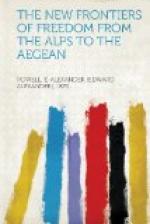Ah! Now you touch the very heart of the whole matter; now you have put your finger on the secret fear which has animated Italy throughout the controversy over Fiume and Dalmatia. For I do not believe that it is a reincarnated Germany which Italy dreads. It is something far more ominous, more terrifying than that, which alarms her. For, looking across the Adriatic, she sees the monstrous vision of a united and aggressive Slavdom, untold millions strong, of which the Jugoslavs are but the skirmish-line, ready to dispute not merely Italy’s schemes for the commercial mastery of the Balkans but her overlordship of that sea which she regards as an Italian lake.
Jugoslavia’s claims to Fiume are more briefly stated. Firstly, she lays title to it on the ground that geographically Fiume belongs to Croatia, and that Croatia is now a part of Jugoslavia, or, to give the new country its correct name, the Kingdom of the Serbs, Croats, and Slovenes. This claim is, I think, well founded, and this despite the fact that Italy has attempted to prove, by means of innumerable pamphlets and maps, that Fiume, being within the great semi-circular wall formed by the Alps, is physically Italian. The Jugoslavs demand Fiume, secondly, because, they assert, if Fiume and Sussak are considered as a single city, that city has more Slavs than Italians, while the population of the hinterland is almost solidly Croatian. With the first half of this claim I cannot agree. As I have already pointed out, Sussak is not, and never has been, a part of Fiume, and its annexation is not demanded by the Italians. Conceding, however, for the sake of argument, that Fiume and Sussak are parts of the same city, the most reliable figures which I have been able to obtain show that, even were the Slav majority in Sussak added to the Slav minority in Fiume, the Slavs would still be able to muster barely more than a third of the total population. By far the strongest title which the Slavs have to the city, and the one which commands for them the greatest sympathy, is their assertion that Fiume is the natural and, indeed, almost the only practicable commercial outlet for Jugoslavia, and that the struggling young state needs it desperately. In reply to this, the Italians point out that there are numerous harbors along the Dalmatian coast which would answer the needs of Jugoslavia as well, or almost as well, as Fiume. Now, I am speaking from first-hand knowledge when I assert that this is not so, for I have seen with my own eyes every harbor, or potential harbor, on the eastern coast of the Adriatic from Istria to Greece. As a matter of fact, the entire coast of Dalmatia would not make up to the Jugoslavs for the loss of Fiume. The map gives no idea of the city’s importance as the southernmost point at which a standard-gauge railway reaches the Adriatic, for the railway leading to Ragusa, to which the Italians so repeatedly refer as providing an outlet for Jugoslavia, is not only narrow-gauge but is in part a rack-and-pinion mountain line. The situation is best summed up by the commander of the American war-ship on which I dined at Spalato.




